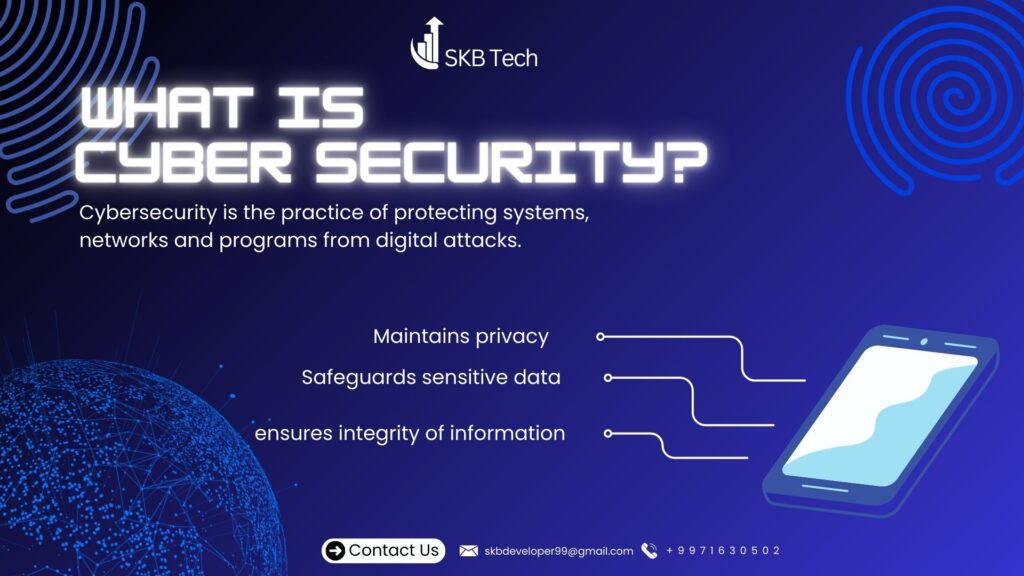The Importance of Cybersecurity in IT: Protecting Data in the Digital Age
As businesses and organizations increasingly depend on technology, the importance of cybersecurity in information technology (IT) has become a priority. From data breaches to phishing attacks, cyber threats are evolving at a rapid pace, putting sensitive data and organizational infrastructure at risk. This article explores the critical importance of cybersecurity in IT, highlighting key areas such as data protection, threat prevention, and best practices for maintaining a secure digital environment.

What is Cybersecurity?
Cybersecurity encompasses the technologies, processes, and practices designed to protect networks, computers, and data from unauthorized access, attacks, damage, or theft. With the rise of digitalization, cybersecurity has become integral to the IT framework, ensuring that both individuals and organizations are safeguarded against cyber threats.
1. Protecting Sensitive Data
Data is the lifeblood of modern businesses, containing valuable information about customers, employees, and operations. Cybersecurity in IT is essential to protect this sensitive data from falling into the wrong hands. A data breach can result in severe consequences, including financial loss, reputational damage, and legal liabilities.
Common Types of Data at Risk:
- Personal Information: Names, addresses, social security numbers, and financial details.
- Intellectual Property: Trade secrets, patents, and proprietary information.
- Operational Data: Business plans, vendor agreements, and employee records.
By implementing strong cybersecurity measures, organizations can prevent unauthorized access, keeping their data secure and maintaining trust with clients and stakeholders.
2. Preventing Financial Loss
Cyberattacks often result in significant financial loss due to the cost of recovering systems, compensating affected customers, and potential legal fees. In fact, studies have shown that the global cost of cybercrime is expected to exceed trillions of dollars annually. Strong cybersecurity practices in IT can prevent these costly breaches, saving companies from devastating financial repercussions.
Key Statistics on Cybersecurity and Financial Loss:
- The average cost of a data breach can range from thousands to millions of dollars, depending on the industry and the nature of the attack.
- Small and medium-sized businesses are especially vulnerable, with up to 60% of small businesses closing within six months of a cyberattack.
By prioritizing cybersecurity, companies not only avoid the direct costs of a breach but also prevent indirect costs like lost productivity and customer trust.
3. Building Customer Trust
In today’s digital world, customers expect companies to protect their personal data. A data breach can harm a brand’s reputation, resulting in lost customers and damaged relationships. Implementing robust cybersecurity measures helps build customer trust, as it reassures them that their information is in safe hands.
Steps to Build Trust with Cybersecurity:
- Transparency: Inform customers about data collection and protection measures.
- Data Encryption: Ensure that sensitive data is encrypted during storage and transmission.
- Privacy Policies: Develop and communicate privacy policies that detail how data is handled and protected.
By demonstrating a commitment to cybersecurity, businesses can strengthen their relationships with customers, fostering loyalty and enhancing their brand reputation.
4. Ensuring Business Continuity
Cyberattacks can disrupt operations, causing significant downtime that can cripple business activities. For instance, ransomware attacks lock companies out of their own systems, forcing them to pay a ransom or lose critical data. Effective cybersecurity strategies are essential for ensuring business continuity by protecting IT infrastructure, minimizing disruptions, and quickly recovering from any attacks that do occur.
Business Continuity Practices:
- Regular Backups: Maintain backup copies of data to restore systems after an attack.
- Disaster Recovery Plan: Develop and test a plan for recovering IT systems after a cyber incident.
- Incident Response Team: Establish a dedicated team trained to respond to cyber incidents quickly and effectively.
A well-prepared organization can respond to cybersecurity incidents without interrupting core business functions, ensuring seamless operations despite potential threats.
5. Cybersecurity Best Practices for Organizations
To maintain a secure IT environment, businesses should follow cybersecurity best practices. These practices are designed to protect against common threats and provide a solid defense against cyber risks.
a. Employee Training
Human error is a significant factor in cybersecurity breaches. Training employees to recognize phishing attempts, avoid suspicious links, and follow secure practices is essential. Regular training sessions help employees stay vigilant and aware of the latest threats.
b. Multi-Factor Authentication (MFA)
MFA adds an additional layer of security by requiring users to verify their identity through multiple means, such as a password and a code sent to their phone. MFA makes it harder for unauthorized users to access sensitive systems, even if they have the primary login credentials.
c. Data Encryption
Encryption is the process of encoding data so only authorized parties can access it. Encryption protects data in transit and at rest, making it unreadable to hackers who may intercept it.
d. Regular Software Updates
Keeping software up to date is crucial for cybersecurity. Software providers frequently release patches to fix vulnerabilities; failing to update systems leaves them open to exploitation.
e. Use of Firewalls and Antivirus Software
Firewalls and antivirus programs are essential for detecting and blocking threats. Firewalls monitor incoming and outgoing traffic, while antivirus software scans systems for malicious files.
6. The Role of Cybersecurity in IT Compliance
Many industries, including finance, healthcare, and government, are subject to strict regulations for data protection and cybersecurity. Complying with these regulations, such as GDPR, HIPAA, and PCI-DSS, is critical for legal operations and avoiding penalties. By implementing cybersecurity measures, organizations ensure they comply with relevant regulations, protecting themselves from fines and legal consequences.
Conclusion
In the age of digital transformation, the importance of cybersecurity in IT cannot be overstated. Cybersecurity not only protects sensitive data and maintains customer trust but also ensures business continuity and regulatory compliance. As cyber threats continue to evolve, organizations must prioritize cybersecurity as a fundamental aspect of their IT strategy. With the right measures in place, companies can safeguard their operations, maintain a strong reputation, and thrive in a digital world. The Importance of Cybersecurity in IT: Protecting Data in the Digital Age.
For more know contact us and check out our other platforms






